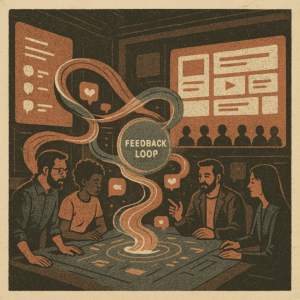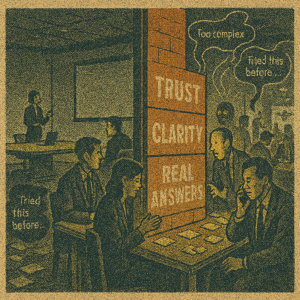Most industries are littered with partial answers.
Searches return blog posts that scratch the surface, listicles that skim by, or overviews that assume too much. The result? People rely on Slack channels, DMs, or old PDFs from former colleagues to get their jobs done.
This is your opportunity.
If you’re a marketer inside a sales-led company, a “Missing Manual” series could be your most powerful asset. It builds authority, helps your sales team, fuels SEO, and creates the kind of evergreen content your competitors wish they had the patience to make.
Let’s unpack how to plan and execute one — borrowing the best ideas from the likes of Animalz, Foundation Inc., and Orbit Media.
What Is a “Missing Manual” Series?
A Missing Manual is a deep, structured guide to a problem or process that matters in your industry — and that nobody has taken the time to fully explain.
Think of it as the opposite of fluff. It doesn’t just describe the what, it explains the how. It’s the kind of content a new hire would bookmark, a potential customer would share with their team, and your sales rep would send with confidence.
And it doesn’t need to be written all at once.
Phase 1: Spot the Gap No One Else Has Filled
Start by asking: What should exist, but doesn’t?
Animalz refers to this as your “content differentiation opportunity.” In their Content Strategy Maturity Model, they point out that as industries mature, content shifts from high-level thought leadership to detailed, operational content. Your Missing Manual should live squarely in that zone.
Look for:
- Repetitive questions from customers or prospects
- Slack threads where your own team struggles to explain something
- Industry processes that are often misunderstood or poorly documented
- Onboarding material that only lives in someone’s head
Tools like Foundation’s Content Market Fit framework can help here too. Their advice? Focus on content that aligns tightly with your audience’s most urgent needs and distribution environments. If a gap exists and it matters to your market, you’re onto something.
Phase 2: Create Standalone Posts That Hit Other Marketing Goals
Here’s where it gets smart.
Rather than trying to write the full manual from day one, break it into standalone blog posts.
Orbit Media’s content strategy framework emphasizes reusable, strategic assets. This is exactly that. Each post should:
- Stand alone with a clear angle
- Solve a specific problem in detail
- Support a known business need (SEO, thought leadership, social sharing, sales enablement)
Think of these as content modules. They do real work in your ecosystem now, but they’re also laying the foundation for something greater.
Phase 3: Distribute + Gather Feedback
Don’t wait for perfection.
Use these posts to power your:
- LinkedIn company page and team accounts
- Sales rep sequences and outbound messaging
- Email newsletters
- Guest post pitches or syndication partnerships
This stage does two things:
- It gets value from day one
- It gives you feedback
Which posts get shared? Spark replies? Earn saves? Lead to demos? That’s your signal that you’re hitting a nerve.
Phase 4: Repackage the Best into Your Missing Manual
Now that you’ve battle-tested the content, pull it together.
Use a tool like Still Works or any modular content system to:
- Combine related posts into sections or chapters
- Write connective intros, transitions, and summaries
- Add diagrams, screenshots, or bonus templates
Foundation Inc. calls this kind of content “pillar-worthy.” Orbit might refer to it as a content hub. Animalz would say it’s “timeless, compounding content.”
We say it’s the best of both worlds: field-tested, feedback-driven, and ready to scale.
Bonus: Involve the Sales Team From the Start
If you’re in a sales-led org, this is non-negotiable.
The sales team knows what confuses people. They hear the questions. They see the objections. Ask them:
- What do buyers misunderstand?
- What’s hard to explain on a call?
- What resource would help them close more deals?
Then show them drafts early. Get their take. Ask for feedback. Let them co-own it.
This makes it far more likely they’ll actually use the content later.
Why This Works So Well
Because it doesn’t just tick a single box.
It ticks many:
- SEO: Long-tail, specific content performs well over time
- Sales Enablement: Reps have trusted resources to send
- Brand Authority: You become the go-to resource in your space
- Repurposing: One manual can spin out diagrams, social posts, webinars, videos, and more
And most importantly: it’s built on real audience insight, not assumptions.
Final Thoughts: You Don’t Need Permission
If you’re a solo marketer or junior content lead, here’s the truth:
You don’t need to pitch the full series. Just start writing. Build standalone posts that your team and sales org already need.
The Missing Manual is a mindset as much as a format.
Start capturing what others overlook. Start documenting what nobody else will. And over time, you’ll build something that not only earns traffic, but actually matters to the people around you.
TL;DR
- A “Missing Manual” series fills the documentation gap in your industry
- Start small with modular, useful blog posts
- Distribute them across your channels and gather feedback
- Repackage into an authoritative, evergreen guide
- Involve sales early to ensure relevance and buy-in
- Build something once that works many times over
Done well, it becomes the go-to guide your industry didn’t know it needed — and the one only you were smart enough to write.


